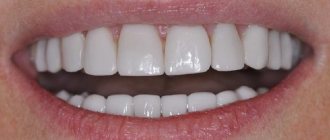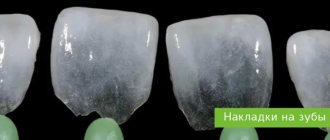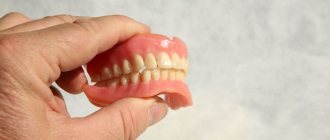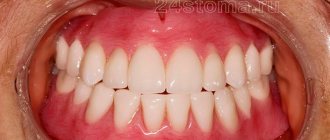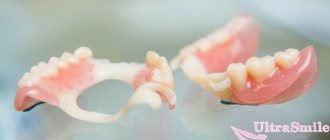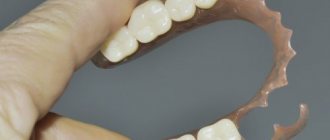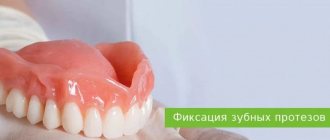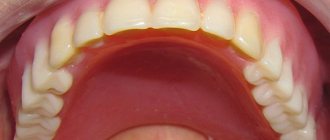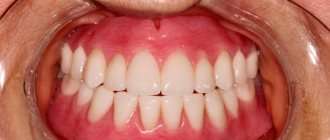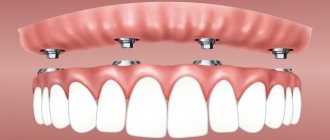Complete removable dentures are a simple and affordable prosthetic option for complete absence of teeth. They do not require surgical interventions and are much cheaper than implant-supported prostheses. If they are made “conscientiously”, they provide a decent result in terms of aesthetics and functionality. They are created in the Center’s own dental laboratory. The task of our specialists is break existing stereotypes and make removable dentures as comfortable and reliable as possible.
Removable dentures - an affordable alternative to implantation
When a person has lost all his teeth and needs them quickly restored, a complete removable denture can be the ideal solution to the problem. However, the vast majority of patients associate it with an uncomfortable denture that constantly falls out of the mouth, which must be placed in a cup at night. Such speculations are relics of the past.
The removable denture of the upper jaw is aesthetically indistinguishable from its teeth
A modern removable denture (if it is properly manufactured) is aesthetic, comfortable and functional . It is a structure in the form of a plastic gum and crowns attached to it. Fixation in the mouth is ensured by the effect of suction to the gums. Artificial elements look extremely natural, no one will guess about your problem.
Undoubtedly, prostheses without any support have worse fixation, and at this point completely removable structures are inferior to prostheses with implant fixation. But if there are contraindications or certain fears of surgery, this is the only way out.
Clasp dentures –
Let’s say right away that there is nothing better than clasp dentures in case of partial absence of teeth. Prostheses of this type differ from prostheses made of nylon and plastic in that they have a metal frame (arch) inside. The use of a reinforcing metal frame, on which a pink plastic or nylon base with artificial teeth is then installed, allows you to significantly reduce the size of the denture base.
So, for example, it is possible to make a removable denture for the upper jaw without a palate, or rather, only a thin metal arch will pass through the palate. On the lower jaw in the sublingual space there will also be no massive denture base, because there will also be an almost imperceptible thin metal arc (Fig. 6). All this provides high comfort when wearing a prosthesis, talking, and eating.
Clasp removable denture for the upper jaw: before and after photos
Clasp removable denture for the lower jaw: before and after photos
Fixation of clasp dentures on supporting teeth is carried out in two ways –
- Fixation using a system of clasps (Fig. 20) - clasps are branches of a cast metal frame. Dentures with such a fixation system are very reliable and comfortable, but they have one drawback - in some situations, metal clasps can fall into the smile line, and then they will be clearly visible.
However, in some clinical situations it is possible to install clasps in such a way that they are practically not noticeable when smiling. In addition, there is now a technology that allows you to make clasps that fall into the smile line not from metal, but from nylon. This nylon clasp can be white or pink, and is practically invisible on the teeth or gums. - Fixation using micro-locks - attachments (Fig. 21) is the most technologically advanced and aesthetic type of removable denture, which has only one drawback - high price. With this type of prosthetics, the supporting teeth are necessarily placed under metal-ceramics (if the prosthesis is one-sided, then there are only 2 crowns, and if the prosthesis is double-sided, then there are only 4 crowns - two on each side.
On these crowns there are 1 or two micro-locks (attachments), or rather only half of the micro-locks. The second halves of the micro-locks are located in the body of the clasp prosthesis. When the prosthesis is put on, the micro-locks snap into place and the prosthesis is securely fixed to the supporting teeth. Such micro-locks are absolutely invisible when you smile, and you get excellent aesthetics.
Advantages of clasp dentures –
Reviews about clasp dentures are only positive. For example, dentures made of plastic or nylon transfer the chewing load from the denture only to the tissue of the prosthetic bed (gum), which in some cases leads to uncomfortable, painful chewing. The clasp distributes the chewing load between the gum and supporting teeth approximately equally, which gives high chewing efficiency and chewing comfort. You can read about all the positive reviews by clicking on the link above.
In addition, these dentures have very good fixation to the supporting teeth (either using clasps or micro-locks). You must understand that there are situations in the oral cavity when none of all types of removable dentures will fit well on the teeth, for example, except for clasps with micro-locks. We are talking about the so-called end defects of the dentition (especially one-sided ones), when the last teeth are completely absent.
Clasp removable dentures: price
- With clasp fixation - in Moscow on average from 30,000 to 40,000 rubles, in the regions - from 20,000 to 35,000 rubles (the price largely depends on the complexity of manufacturing such a prosthesis in a specific clinical situation, according to which clasps are usually divided into simple and complex).
- With locking fixation - double-sided clasp with fixation on 2 micro-locks like Bredent (Germany) - from 80,000 rubles.
This price already includes everything: the cost of the prosthesis itself, the cost of 4 metal-ceramic crowns, the cost of micro-locks. One-sided clasp prosthesis with micro-locks - from 40,000 to 50,000 rubles (the price also already includes: the cost of the prosthesis itself, the cost of 2 metal-ceramic crowns, the cost of micro-locks).
Advantages
- Cost Compared to implantation, they are much cheaper. In addition, there is no need to undergo surgery, only if necessary, to remove the remaining failed teeth.
- Speed Manufacturing takes 1-2 weeks, while implantation with preparation of the oral cavity, bone tissue building and implant engraftment takes at least 4 months.
- Comfort If the prosthesis is made of high-quality materials and the features of the dentofacial apparatus are taken into account, after adaptation it feels like your own dentition in the mouth.
- Aesthetics Thanks to the use of advanced materials, modern orthopedic protocols and technologies, the artificial jaw looks completely natural.
A complete removable denture is a quick and affordable solution for missing teeth.
This is the only alternative to implantation and the opportunity to replace all lost teeth without surgery and significant costs. Modern dentures have come a long way in terms of aesthetics and comfort. With the proper work of an orthopedist and dental technician, they do not fall out, do not rub, and are not noticeable to others.
Levin Dmitry Valerievich Chief physician and founder of the Doctor Levin center
What is chewing efficiency
As you know, the oral cavity is also the beginning of the digestive tract. After preliminary thorough grinding, food enters the stomach through the esophagus. Therefore, a very important factor in healthy digestion is the concept of chewing efficiency - this is the work that is actually performed by the chewing apparatus, of which the teeth are an integral part. A loss of 40% of chewing efficiency is the limit that leads to digestive disorders and is an absolute indication for prosthetics.
Types of removable dentures in complete absence of teeth
The base of complete dentures (artificial gum) can be made of different materials
Prices
Free online consultation with a dentist
| Service | Price |
| Installation of a temporary cosmetic plate (butterfly) | from 11,000 rub. |
| Installation of a complete or partially removable lamellar denture (acrylic, 1 jaw) | from 32,000 rub. |
| Installation of a partially removable nylon prosthesis (1 jaw) | from 40,000 rub. |
| Installation of a clasp denture with clasps (1 jaw) | from 40,000 rub. |
| Installation of a complete removable denture Akri Free (1 jaw) | from 47,000 rub. |
| Installation of a one-stage multi-unit implant with screw fixation (Switzerland, Trate AG) with an adaptation crown | from 50,000 rub. |
| Installation of a splinting clasp prosthesis (1 jaw) | from 55,000 rub. |
| Installation of a partially removable clasp prosthesis Quadrotti (1 jaw) | from 64,500 rub. |
| Installation of a locking clasp prosthesis (1 jaw) | from 70,000 rub. |
| Installation of a clasp denture on telescopic crowns (1 jaw) | from 75,000 rub. |
| Conditionally removable acrylic prosthesis on spherical attachments Rhein-83 for 1 jaw | from 121,000 rub. |
| Installation of a complete metal-plastic bridge prosthesis on one-stage implants of the ROOTT system (alloy Germany, plastic Japan - 1 jaw), cement fixation | from 130,000 rub. |
| Installation of a complete metal-plastic bridge prosthesis on one-stage implants of the ROOTT multi-unit system with screw fixation (Germany alloy, on a metal frame, Japan plastic - 1 jaw) | from 155,000 rub. |
| Installation of a complete metal-plastic bridge prosthesis on one-stage implants of the ROOTT multi-unit system with screw fixation (Germany alloy, on a titanium frame, Japan plastic - 1 jaw) | from 175,000 rub. |
| Installation of a full bridge ceramic-composite prosthesis on one-stage implants (Germany alloy, on a metal frame, Japan composite - 1 jaw) with cement fixation | from 230,000 rub. |
| Installation of a complete metal-ceramic bridge prosthesis on one-stage implants of the ROOTT system on a metal frame, 1 jaw, cemented fixation | from 210,000 rub. from 250,000 rub. promotion |
| Installation of a full bridge ceramic-composite prosthesis on one-stage implants (Germany alloy, on a titanium frame, Japan composite - 1 jaw) with cement fixation | from 250,000 rub. |
| Installation of a complete metal-ceramic bridge prosthesis on one-stage implants of the ROOTT multi-unit system with screw fixation, 1 jaw, metal frame | from 230,000 rub. from 270,000 rub. promotion |
| Installation of a complete bridge made of zirconium dioxide on one-stage implants of the ROOTT system, 1 jaw, cemented fixation | from 320,000 rub. |
| Installation of a complete PREMIUM ceramic-composite bridge prosthesis on one-stage implants of the ROOTT multi-unit system with screw fixation on a titanium frame CONDYLAR - stage II | from 320,000 rub. |
| Installation of a complete bridge made of zirconium dioxide on one-stage implants of the ROOTT multi-unit system with screw fixation, 1 jaw | from 370,000 rub. |
| Installation of a full bridge ceramic-composite prosthesis on one-stage implants of the ROOTT system on a reinforced titanium milling frame with a stump for each tooth of increased aesthetics on cement fixation, 1 jaw, stage II (SHOFU ceramic composite, Japan) | from 400,000 rub. |
| Installation of a full bridge ceramic-composite prosthesis on one-stage implants of the ROOTT system on a reinforced titanium milling frame with a stump for each tooth of increased aesthetics on a screw fixation, 1 jaw, stage II (SHOFU ceramic composite, Japan) | from 420,000 rub. |
| Installation of a full ceramic bridge on one-stage implants of the ROOTT multi-unit system with screw fixation with individual IMAX crowns on a reinforced PREMIUM titanium milling frame, 1 jaw, stage II | from 480,000 rub. |
Consultation and diagnostics are free!
All prices Promotions
Sign up for a consultation
three ROOTT specialists + diagnostics as a gift
Features of fixation on the upper and lower jaw
Removable dentures are held in the mouth due to the creation of a vacuum between the gum and the base (suction effect) and the anatomical features of the jaws
- On the upper jaw Fixation is carried out by blocking the palate. Increasing the contact area allows you to securely secure the artificial dentition, but leads to a decrease in comfort while wearing.
- to the lower jaw only due to the suction effect to the gums; in this case, it will not be possible to increase the contact area due to anatomical features. Therefore, the quality of fixation from below is always worse.
When using removable prosthetics, it is extremely important that the design exactly replicates the anatomy of the prosthetic bed . Otherwise, it will not be possible to achieve its stability, and under load the teeth will fly off. This is not the only problem with complete dentures; it is also worth noting:
- bulkiness, overlap of the palate with prosthetics of the upper jaw
- need for careful hygienic care
- discomfort, rubbing of the mucous membrane in the first 1-2 weeks of wearing
- resorption of bone tissue under the prosthesis.
Despite the shortcomings, if you approach the problem correctly, any negative aspects can be minimized.
Chashchin Kirill Valerievich
Orthopedic dentist, 14 years of experience
Virtuoso of prosthetics. Competent planning and diagnostics, creation of comfortable removable dentures taking into account individual parameters.
More about the doctor
Crowns and bridges
The crown completely covers the tooth and allows you not only to reliably strengthen it, but also to change the shape, color and size, which is especially important for aesthetic defects.
Bridges It can also be installed on an implant or be part of a bridge.
The materials used for manufacturing are gold, metal alloys, plastic, ceramics, porcelain, zirconium. Metal crowns are more durable, but less aesthetically pleasing, so they are often installed on the side areas. Ceramic, porcelain and zirconium are highly aesthetic. This is important to consider when prosthetizing the anterior sections of the upper jaw .
Bridge structures are used to restore one or more missing teeth and, based on neighboring ones, fill the resulting space. Implants can also serve as support. Advantages: high aesthetics, strength and durability of structures, ease of care, no displacement when chewing or talking, the ability to completely change the appearance of teeth in particular and smiles in general, as well as their restoration in case of significant destruction of the coronal part. The dentist will help you make the right choice based on the situation in the oral cavity, aesthetics and cost acceptable to the patient.
Using a facebow and articulator for correct bite
The only possibility in case of complete edentia is to determine the relationship of the jaws. We use SAM3, Protar or Amann Girrbach systems
- Manufacturing a precise prosthesis taking into account the individual characteristics of the jaw system
- Prevention of temporomandibular joint dysfunction
Rules for wearing and caring for prostheses
The first time after installation, removable dentures can cause discomfort. As a rule, it goes away by the end of the first week. In some cases, especially when using plate structures, addiction can last up to 3 weeks.
To speed up adaptation, there are general rules and recommendations: rinse your mouth with warm water more often, do not overload the denture with solid food for the first 3-4 days.
Carefully monitor hygiene, rinse your mouth after every meal, and beware of excessive chewing loads. For cleaning, you should not use abrasive cleaners; give preference to special solutions and pastes.
Stages of prosthetics
Creating a comfortable prosthesis with a minimal adaptation period will require several visits to the clinic. To eliminate inaccuracies in manufacturing, several pairs of impressions, fittings and bite testing are necessary.
- Taking impressions Taking preliminary impressions of the jaws to make a plaster model and final impressions to make a prosthesis template with the exact boundaries of the base.
- Bite study Determination and fixation of central occlusion based on facial characteristics using a facebow for transfer to the articulator in order to recreate the bite.
- Creating a template In the laboratory, the artificial teeth are first placed in the articulator on a wax template, taking into account the occlusion and the data obtained during the diagnosis.
- Try-ons The patient can visually evaluate the result and determine the degree of comfort. The doctor determines the relationship of the jaws in the oral cavity and their correspondence to facial features.
- Making a prosthesis When the template of the prosthesis is perfected, in the laboratory the model goes through a technological stage, the wax is replaced with a permanent plastic base through polymerization.
- Check in the articulator The bite is fixed with the finished prosthesis, the closure of the jaws is checked in the articulator in the clinic. If the smallest deviations are detected, adjustments are made.
The finished prosthesis is fixed to the jaw by applying slight pressure. Next comes the most important stage - getting used to or adapting to a removable denture. Sometimes there may be some discomfort in the first 1-2 weeks. It may be necessary to make a few more adjustments - we bring the prosthesis to an ideal state so that the person is extremely comfortable and convenient, so that he stops feeling it .
Lifespan of removable partial dentures
Practice shows that the service life of removable plate structures is on average 3-5 years, after which the structure has to be changed. Bugel products have a longer lifespan - up to 5-7 years.
In general, the duration of wearing depends on several factors:
— the quality of the design and the professionalism of the specialist who carried out the installation;
— characteristics of the body and the condition of the oral cavity, the presence of gum diseases and deformation of the dentition;
— accuracy of compliance with doctor’s recommendations and proper home care.
What is important to pay attention to!
The most important part of the clasp prosthesis is its metal frame with a fixation system built into it. Initially, the frames of clasp dentures were made only by casting, for which a cobalt-chromium alloy (CCH) was used. Nowadays, the method of one-piece casting on a refractory model is still widely used, but more modern methods have now appeared that make it possible to increase the accuracy of the manufacture of this prosthesis in the dental laboratory.
For example, frames can be made using the modern method of “selective laser melting”, not only from CCS, but also from titanium. The use of titanium made it possible to both increase the strength of the metal frame (titanium is 5 times stronger than KHS) and reduce the weight of the clasp prosthesis by approximately 2 times. Reducing the weight of the prosthesis greatly facilitates getting used to it. Another modern method of manufacturing a metal frame for partial dentures, as well as caps for telescopic crowns, is milling on a computer-controlled machine (CAD/CAM technology).
You need to find out which method will be used to make your particular prosthesis during your initial consultation with your dentist. As a rule, small clinics that have their own dental laboratory do not have special milling equipment and a machine for selective laser melting (due to their high cost). We hope that our article: Clasp dentures reviews, price – was useful to you!
Sources:
1. Personal experience as a dentist, 2. “Orthopedic dentistry. Textbook" (Trezubov V.N.), 3. National Library of Medicine (USA), 4. https://www.realself.com/, 5. "Removable dentures: a textbook" (Mironova M.L.), 6 "Teeth restoration with clasp dentures (Fadeev R.A.).

